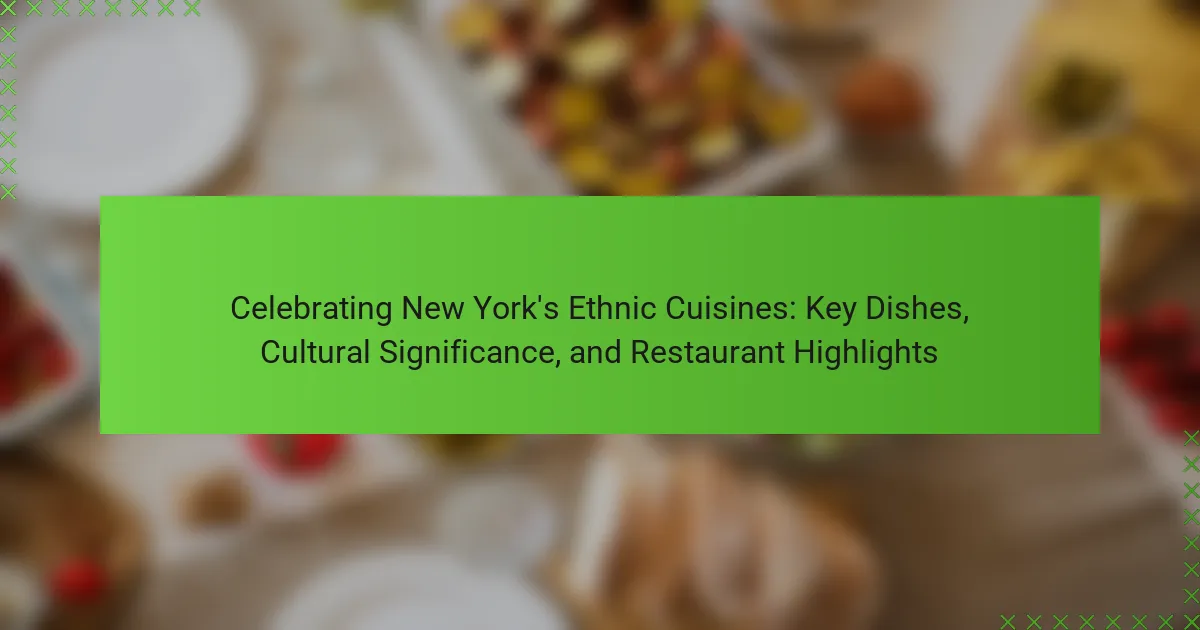
What are the key ethnic cuisines represented in New York?
New York is home to a diverse array of key ethnic cuisines. Prominent among them are Italian, Chinese, Mexican, Indian, and Jewish cuisines. Italian cuisine is represented by classic dishes like pizza and pasta. Chinese cuisine features popular items such as dim sum and Peking duck. Mexican cuisine includes tacos and enchiladas, reflecting the city’s vibrant Hispanic community. Indian cuisine showcases dishes like curry and samosas, highlighting its rich flavors. Jewish cuisine offers bagels and pastrami sandwiches, rooted in the city’s history. Each cuisine contributes to New York’s culinary landscape, making it a melting pot of flavors and traditions.
How do these ethnic cuisines reflect the city’s diversity?
Ethnic cuisines in New York reflect the city’s diversity through their variety and cultural significance. Each cuisine represents the traditions and histories of different immigrant communities. For example, Italian cuisine showcases the influence of Italian immigrants from the late 19th century. Chinese cuisine highlights the long-standing presence of Chinese communities, especially in neighborhoods like Chinatown.
The availability of diverse dishes, such as tacos, sushi, and curry, illustrates the city’s multicultural landscape. Restaurants often serve traditional recipes passed down through generations, maintaining cultural heritage. Food festivals and cultural events further celebrate this diversity, bringing communities together.
According to a 2019 report by the New York City Department of City Planning, over 200 languages are spoken in the city, reflecting its rich ethnic tapestry. This linguistic diversity is mirrored in the wide range of cuisines available. Thus, ethnic cuisines serve as a culinary representation of New York’s vibrant and diverse population.
What are some historical influences on New York’s ethnic cuisines?
New York’s ethnic cuisines are influenced by its diverse immigrant populations. Each wave of immigration brought unique culinary traditions. For example, Italian immigrants introduced pizza and pasta in the late 19th century. Jewish immigrants contributed bagels and deli foods in the early 20th century. Chinese immigrants established the first Chinatown, popularizing dishes like chop suey. The Caribbean community introduced flavors through jerk chicken and rice and peas. Each ethnic group adapted their recipes to local ingredients and tastes. This fusion created a rich tapestry of flavors in New York’s food scene. Historical events, such as the Great Migration, further diversified the culinary landscape.
How do immigration patterns shape the culinary landscape?
Immigration patterns significantly shape the culinary landscape by introducing diverse cuisines. Each wave of immigrants brings unique food traditions and ingredients. For example, Italian immigrants popularized pizza and pasta in the early 20th century. Similarly, Chinese immigrants introduced dishes like chop suey and dim sum. These culinary influences often blend with local ingredients and cooking methods. This fusion creates new dishes that reflect cultural diversity. According to the New York City Department of Health, over 200 nationalities contribute to the city’s food scene. This rich tapestry of flavors enhances the overall dining experience.
What are some signature dishes from New York’s ethnic cuisines?
New York’s ethnic cuisines feature signature dishes such as bagels, dim sum, and tacos. Bagels, originating from Jewish culture, are often served with cream cheese and lox. Dim sum, a staple of Cantonese cuisine, includes small plates of dumplings and buns. Tacos, popular in Mexican cuisine, are typically filled with meats, beans, and fresh toppings. Each dish reflects the diverse cultural influences in New York. The city’s culinary scene is a blend of traditions from around the world. This variety showcases the rich tapestry of flavors and techniques that define New York’s food culture.
What ingredients are commonly used in these dishes?
Common ingredients in New York’s ethnic dishes include rice, beans, spices, and fresh vegetables. For instance, in Latin American cuisine, black beans and cilantro are staples. Italian dishes often feature tomatoes, garlic, and basil. Asian cuisines frequently use soy sauce, ginger, and scallions. Middle Eastern food commonly incorporates chickpeas, tahini, and spices like cumin. These ingredients reflect the diverse cultural influences present in New York’s culinary landscape.
How do cooking methods vary across different ethnic cuisines?
Cooking methods vary significantly across different ethnic cuisines due to cultural traditions and ingredient availability. For instance, Italian cuisine often emphasizes techniques like sautéing and baking, particularly in pasta and pizza preparation. In contrast, Asian cuisines, such as Chinese and Thai, frequently utilize stir-frying and steaming to enhance flavors while preserving nutrients.
Middle Eastern cuisines often incorporate grilling and slow-cooking methods, evident in dishes like kebabs and tagines. African cuisines may feature techniques like frying and stewing, utilizing local spices and ingredients.
These variations reflect historical influences, regional climates, and available resources. Each method contributes distinct textures and flavors, showcasing the diversity of global culinary practices.
What cultural significance do these ethnic cuisines hold?
Ethnic cuisines hold significant cultural importance as they reflect the history, traditions, and values of their respective communities. These cuisines serve as a means of preserving cultural identity and heritage. For example, Italian cuisine showcases regional ingredients, cooking techniques, and family recipes passed down through generations. Similarly, Chinese cuisine embodies centuries of cultural evolution and regional diversity.
Ethnic cuisines also promote social cohesion within communities. Shared meals often facilitate gatherings and celebrations, strengthening bonds among family and friends. Additionally, these cuisines contribute to cultural exchange and understanding in multicultural settings.
In New York, ethnic cuisines play a vital role in the city’s identity. The diverse food landscape demonstrates the city’s immigrant history. According to the New York City Department of City Planning, over 36% of the city’s population is foreign-born, enriching the culinary scene. This diversity allows residents and visitors to experience authentic flavors from around the world, fostering appreciation for different cultures.
How do food festivals celebrate New York’s diverse cuisines?
Food festivals celebrate New York’s diverse cuisines by showcasing a variety of cultural dishes. These events feature food from different ethnic backgrounds, reflecting the city’s multicultural population. Vendors often represent specific communities, offering authentic recipes and traditional cooking methods. Festivals also host cooking demonstrations, allowing chefs to share their culinary techniques. Live music and performances enhance the cultural experience, creating an immersive environment. Many festivals include competitions, encouraging local chefs to innovate while honoring their heritage. According to the New York City Department of Cultural Affairs, these festivals foster community engagement and promote cultural understanding. Overall, food festivals serve as a platform for celebrating the rich culinary tapestry of New York.
What role do ethnic cuisines play in community identity?
Ethnic cuisines play a crucial role in shaping community identity. They serve as a medium through which cultural heritage is expressed. Food traditions reflect historical narratives and shared experiences of a community. For instance, Italian-American cuisine highlights the immigrant experience and adaptation in New York. Similarly, Chinese cuisine showcases the integration of flavors and techniques from both China and the United States. Ethnic foods foster social connections and community gatherings, reinforcing bonds among members. Research indicates that shared meals contribute to a sense of belonging and identity. Moreover, ethnic cuisines promote cultural diversity and awareness within broader society. They encourage appreciation of different backgrounds, enhancing community cohesion.
How do restaurants highlight New York’s ethnic cuisines?
Restaurants highlight New York’s ethnic cuisines through diverse menus and cultural events. They feature authentic dishes representing various cultures. Many establishments source ingredients from specific regions to ensure authenticity. Chefs often share their cultural heritage through storytelling in their cuisine. Restaurants may host themed nights celebrating particular ethnic traditions. Collaborations with local cultural organizations further promote ethnic awareness. Food festivals in New York showcase a wide array of ethnic dishes. These efforts contribute to the city’s reputation as a culinary melting pot.
What are some must-visit restaurants for experiencing these cuisines?
Katz’s Delicatessen offers iconic Jewish deli cuisine. Established in 1888, it is famous for its pastrami sandwiches. Xi’an Famous Foods specializes in Chinese cuisine, particularly hand-pulled noodles. It has gained acclaim for its spicy lamb noodles. For Italian cuisine, L’Artusi provides modern takes on classic dishes. It is well-known for its ricotta gnocchi. The halal cart at 53rd and 6th is a must-visit for Middle Eastern street food. It serves chicken and rice that attracts long lines daily. For Puerto Rican flavors, try La Fonda Boricua, celebrated for its mofongo. Each of these restaurants embodies the rich ethnic diversity of New York’s culinary scene.
How do restaurant menus reflect cultural authenticity?
Restaurant menus reflect cultural authenticity by showcasing traditional dishes and ingredients specific to a culture. They often include regional specialties that highlight local flavors and cooking methods. Authentic menus may also use native language descriptions, preserving cultural identity. Furthermore, the presentation and arrangement of dishes can mirror traditional dining customs. Research indicates that menus featuring authentic items enhance the dining experience and foster cultural appreciation. This connection between food and culture is vital in diverse culinary landscapes, such as New York’s ethnic cuisines.

What are the trends in New York’s ethnic culinary scene?
New York’s ethnic culinary scene is increasingly characterized by fusion cuisine and authenticity. Restaurants are blending traditional recipes with modern techniques. This trend reflects the city’s diverse population and cultural influences. For example, Korean tacos and Indian pizza are popular items. Additionally, there is a growing emphasis on local ingredients. Chefs are sourcing produce from nearby farms to enhance flavor and sustainability. Plant-based and vegan options are also on the rise across various ethnic cuisines. This shift caters to health-conscious diners while respecting traditional dishes. Moreover, food festivals celebrating ethnic diversity are becoming more common. Events like the NYC Wine & Food Festival showcase this culinary richness. Overall, New York’s ethnic culinary scene continues to evolve, reflecting both innovation and tradition.
How are modern interpretations of traditional dishes emerging?
Modern interpretations of traditional dishes are emerging through fusion cuisine and innovative techniques. Chefs are blending cultural influences to create unique flavor profiles. Ingredients are sourced locally, enhancing freshness and sustainability. Technology plays a role, with molecular gastronomy transforming textures and presentations. Social media influences trends, encouraging creative adaptations. Restaurants often showcase these interpretations to attract diverse clientele. The rise of food blogs and influencers amplifies visibility for these modern dishes. Culinary competitions also inspire chefs to reimagine classics. Overall, this evolution reflects a dynamic food culture that honors tradition while embracing innovation.
What fusion cuisines are gaining popularity in New York?
Korean-Mexican fusion is gaining popularity in New York. This cuisine combines traditional Korean flavors with Mexican dishes. Tacos filled with bulgogi and kimchi are common examples. Another emerging trend is Indian-Chinese fusion. Dishes like chili chicken and paneer fried rice are popular in this category. Japanese-Italian fusion is also on the rise, featuring dishes such as sushi pizza. These fusion cuisines reflect New York’s diverse culinary landscape. They attract food enthusiasts seeking unique dining experiences. The city’s multicultural environment fosters these innovative culinary combinations.
How do chefs balance tradition and innovation in their cooking?
Chefs balance tradition and innovation by respecting culinary heritage while embracing modern techniques. They often start with traditional recipes as a foundation. Chefs then experiment with new ingredients or cooking methods to create unique dishes. For example, a chef may use traditional spices in a contemporary presentation. This approach allows for creativity without losing cultural significance. Many chefs also engage with local communities to understand traditional practices better. This collaboration helps preserve authenticity while allowing for innovation. Ultimately, the balance enhances the dining experience by offering both nostalgia and novelty.
What challenges do ethnic restaurants face in New York?
Ethnic restaurants in New York face several challenges. High competition is a significant issue. There are thousands of dining options in the city. This makes it hard for ethnic restaurants to stand out. Additionally, many ethnic restaurants struggle with sourcing authentic ingredients. Importing these items can be costly and logistically complex. Labor shortages also impact these establishments. Finding skilled staff who understand the cuisine can be difficult. Furthermore, cultural misunderstandings can affect customer experience. Some diners may not be familiar with the cuisine’s nuances. Economic pressures, such as rising rents, also pose challenges. Many ethnic restaurants operate on thin profit margins. These factors combined create a tough environment for ethnic cuisine in New York.
How do economic factors impact these establishments?
Economic factors significantly impact ethnic cuisine establishments in New York. These factors influence pricing, customer demographics, and operational costs. For instance, fluctuations in food prices affect ingredient sourcing. Higher costs may lead to increased menu prices, potentially deterring budget-conscious customers. Additionally, economic downturns can reduce disposable income, impacting dining frequency. Conversely, economic growth can enhance spending on dining out. Research indicates that in 2022, New York’s restaurant industry generated over $50 billion in sales, showcasing its economic importance. Therefore, economic conditions directly shape the viability and success of these establishments.
What role does community support play in their success?
Community support is crucial for the success of ethnic cuisines in New York. It fosters a loyal customer base that appreciates cultural diversity. Local communities often promote their cuisines through word-of-mouth and social media. This organic promotion helps restaurants gain visibility and attract new patrons. Additionally, community events and festivals showcase ethnic foods, enhancing their popularity. Research indicates that 70% of small businesses thrive on community engagement. This engagement not only drives sales but also builds a sense of belonging among diners. Ultimately, strong community support leads to sustained success for ethnic restaurants.

What tips can enhance the experience of exploring New York’s ethnic cuisines?
Explore diverse neighborhoods to discover authentic ethnic cuisines. Each area showcases unique culinary traditions. Engage with local chefs and restaurant owners for deeper insights. Attend food festivals to sample various dishes and learn about their origins. Use food apps to find highly-rated ethnic restaurants nearby. Participate in cooking classes to experience hands-on learning of different cuisines. Read reviews and guides to identify must-try dishes specific to each culture. Embrace street food for a casual yet rich culinary experience.
How can diners discover authentic ethnic dining experiences?
Diners can discover authentic ethnic dining experiences by exploring neighborhoods known for diverse cultures. Areas like Jackson Heights and Astoria in New York City offer numerous ethnic restaurants. Researching online reviews can help identify highly-rated spots. Websites like Yelp and TripAdvisor feature user-generated content on dining experiences. Engaging with local food blogs can provide insights into hidden gems. Attending cultural festivals can also showcase authentic cuisines. Participating in food tours led by knowledgeable guides can enhance the experience. These methods help diners find genuine ethnic dining options that reflect cultural heritage.
What should visitors know about dining etiquette in different cultures?
Visitors should know that dining etiquette varies significantly across cultures. In Japan, it is polite to say “Itadakimasu” before eating. This expresses gratitude for the meal. In Italy, finishing all food on your plate is seen as a compliment to the chef. In some Middle Eastern cultures, eating with the right hand is customary. Using the left hand is considered impolite. In India, it is common to eat with your hands, but washing hands before and after is essential. In many Asian cultures, slurping noodles signifies enjoyment of the meal. In contrast, in Western cultures, slurping is often viewed as rude. Understanding these nuances enhances the dining experience and shows respect for local customs.
How can exploring food markets enrich the culinary journey?
Exploring food markets enriches the culinary journey by providing access to diverse ingredients and authentic flavors. These markets showcase local produce, spices, and specialty items not typically found in conventional grocery stores. Visitors can discover unique ethnic foods that reflect the cultural heritage of the community. Engaging with vendors offers insights into traditional cooking methods and recipes. Food markets often host cooking demonstrations and tastings, enhancing the learning experience. Additionally, they foster connections between consumers and local producers. This interaction promotes a deeper appreciation for culinary traditions and sustainability. Overall, food markets serve as vibrant hubs of cultural exchange and culinary exploration.
The main entity of the article is New York’s ethnic cuisines, which encompass a diverse array of culinary traditions such as Italian, Chinese, Mexican, Indian, and Jewish. The article explores how these cuisines reflect the city’s multicultural landscape and historical influences, emphasizing signature dishes, common ingredients, and cooking methods. It highlights the cultural significance of ethnic cuisines in fostering community identity and social cohesion, as well as the role of restaurants and food festivals in promoting these diverse culinary experiences. Additionally, the article addresses challenges faced by ethnic restaurants and offers tips for discovering authentic dining experiences in New York.
